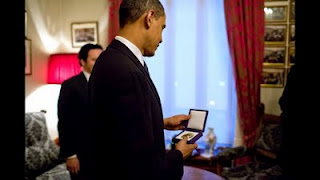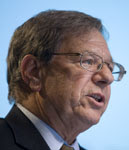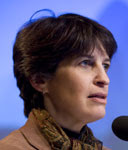-
Healing the Rift: Mitigating Conflict Over Natural Resources in the Albertine Rift
March 2, 2010 // By Dan AsinMORE Conservation practitioners realize they must deal with conflict but often lack the training to do so, says Dr. Andrew Plumptre, director of the Wildlife Conservation Society’s (WCS) Albertine Rift Program. Moreover, they don’t realize their conservation efforts—by restricting access to resources or creating new burdens, costs, and risks for communities—are at times directly responsible for spawning new conflicts where none existed before.
Conservation practitioners realize they must deal with conflict but often lack the training to do so, says Dr. Andrew Plumptre, director of the Wildlife Conservation Society’s (WCS) Albertine Rift Program. Moreover, they don’t realize their conservation efforts—by restricting access to resources or creating new burdens, costs, and risks for communities—are at times directly responsible for spawning new conflicts where none existed before.
In a recent presentation—Healing the Rift: Mitigating Conflict Over Natural Resources in the Albertine Rift, sponsored by WCS and the Africa Biodiversity Collaborative Group—Plumptre used his work with WCS in the Albertine Rift as a launch pad to discuss how conservation practitioners can work to mitigate conflict.
Achieving “Conflict-Sensitive Conservation”
“Conflict-sensitive conservation,” as outlined in an International Institute for Sustainable Development‘s practitioners’ manual developed in conjunction with WCS, is a multi-step process:- Identify—What are the area’s current or potential conflicts?
- Prioritize—Which conflicts are the most serious?
- Target—Which high-risk conflict does my organization possess the capacity to address?
- Analyze—What are the causes and effects of conflict? Who are the stakeholders, what are the relationships between them, and which should we seek to engage?
- Design & implement solutions—With what strategy should the conflict be approached? At which point in the conflict cycle should we seek to intervene?
- Monitor—Continue to watch the area for new developments.
Plumptre’s fieldwork on the DRC’s Virunga National Park is one of the case studies in Renewable Natural Resources: Practical Lessons for Conflict-Sensitive Development, recently published by the World Bank. Conflict in the park began in 1996, when an influx of internally displaced persons from the war in the DRC poured into the area, placing severe strains on the park’s fish, wildlife, timber, and agricultural resources.
In 2006, Plumptre and his WCS colleagues entered Virunga and identified four challenges they could best address:- Overfishing on Lake Edward
- Military poaching
- Park encroachment
- Conflict with displaced Ugandan pastoralists
- To combat overfishing, WCS helped villages establish sustainable targets and implement internal policing mechanisms
- To curtail encroachment and poaching by the military and those living in the greater Virunga National Park area, WCS trained Congolese Park Authority (ICCN) staff in enforcement and monitoring techniques, established channels of communication with military commanders, and engaged in general and targeted environmental educational campaigns.
- To relieve resource pressures from the presence of Ugandan pastoralists, WCS worked with the Congolese and Ugandan governments to ensure pastoralists could safely and freely return to Uganda to settle elsewhere.
Beyond Virunga National Park
Since completing their project in 2007, Plumptre and his team have established similar projects in Kahuzi-Biega National Park, the Itombwe Massif, and Misotshi-Kabogo. Now, however, they are working to prevent conflicts before they take root. WCS has guided communities in the Misotshi-Kabogo area to work together to petition the Congolese government to turn their territory into the DRC’s 8th national park.
Climate change is predicted to spur local, often intra-state or regional, migrations in response to droughts and flooding. Could these migrations lead to similar resource conflicts in the future? The rate of migration, governance and carrying capacities of the absorbing communities, and economic status of the migrants will all come in to play. In cases where conflict might result, Plumptre’s work successfully demonstrates that “conflict-sensitive conservation” should have a place in the peacebuilders’ toolkit. -
Nobel Pursuits: Linking Climate Efforts With Development, Natural Resources, and Stability
December 11, 2009 // By Geoffrey D. DabelkoMOREThe only mention of climate change in President Obama’s Nobel Peace Prize acceptance speech falls squarely in the climate and security context. He introduces the climate imperative by highlighting natural resources and development connections to stability and human well-being.
In these two paragraphs, the President identifies the key communities that must come together, first in dialogue and then in cooperation, but who so commonly don’t: development, natural resources, health, climate, peacebuilding, and security.It is undoubtedly true that development rarely takes root without security; it is also true that security does not exist where human beings do not have access to enough food, or clean water, or the medicine and shelter they need to survive. It does not exist where children can’t aspire to a decent education or a job that supports a family. The absence of hope can rot a society from within.
Photo: President Barack Obama looks at the Nobel Peace Prize medal at the Norwegian Nobel Institute in Oslo, Norway, Dec. 10, 2009 (Official White House Photo by Pete Souza).
And that’s why helping farmers feed their own people — or nations educate their children and care for the sick — is not mere charity. It’s also why the world must come together to confront climate change. There is little scientific dispute that if we do nothing, we will face more drought, more famine, more mass displacement — all of which will fuel more conflict for decades. For this reason, it is not merely scientists and environmental activists who call for swift and forceful action — it’s military leaders in my own country and others who understand our common security hangs in the balance. -
Hot and Cold Wars: Climate, Conflict, and Cooperation
November 23, 2009 // By Sajid AnwarMORE At an American University event on his new book, Climate Change and Armed Conflict: Hot and Cold Wars, the Center for Teaching Excellence’s James Lee identified some plausible scenarios that the international community will have to face to adequately and peacefully address the security impacts of climate change.
At an American University event on his new book, Climate Change and Armed Conflict: Hot and Cold Wars, the Center for Teaching Excellence’s James Lee identified some plausible scenarios that the international community will have to face to adequately and peacefully address the security impacts of climate change.
With the loss of glaciers and normal river flows, international boundaries that have long been determined by these natural barriers will be called into question, Lee said, raising legitimate issues of sovereignty, migration, and land rights. How will countries separated by large glaciers or rivers deal with their more open and easily accessible borders? Will people who depend on these resources migrate into other countries in search of water? How will these changes impact countries that share these resources?
In his presentation, Lee argued that climate change will lead to violent conflict, using the historical record of climate change and conflict to prove his point. But most of the cases cited occurred before the 20th century, and the changes in climate then were much different than what we are now facing.
Today, we live in a world that is truly global in both governance and accountability. Issues such as severe environmental degradation or scarcity can be a factor in conflict within a country, but the potential for climate change to cause an international conflict is not as high as some warn.
There are multiple variables on the causal chain between climate change and conflict that can be addressed now, through national efforts and international cooperation. Countries can start with strong governance initiatives now to ensure that future problems of transboundary water scarcity, migration trends, and border changes do not lead to conflict.
For example, while climate change may lead to water scarcity, declines in agricultural production, and therefore to food insecurity, countries can avoid this outcome by leasing agricultural land in countries that won’t face high levels of water stress.
In addition, countries could avoid future disagreements over territory by negotiating a shared understanding of borders independent of geographic markers such as rivers or glaciers. These and other variables can be addressed now in order to mitigate the risk of future conflicts.
Renegotiating Water, Avoiding Conflict
Uppsala University Professor Ashok Swain, who spoke via Skype, took a different tack than Lee, stating that the links between climate change and conflict lack proper research. He was concerned by the hard security linkages being made with climate change and called for further exploration.
But Swain identified one potential trouble spot: While interactions over shared river systems have been shown to be overwhelmingly cooperative rather than violent, he voiced concern that the changes brought by climate change are not encompassed in the scope of current water-sharing agreements, which could increase the likelihood of conflict, according to Swain.
In the same way that leasing agricultural abroad or negotiating a shared understanding of borders now could help mitigate conflict in the future, so could renegotiating and strengthening current water-sharing agreements to reflect the future effects of climate change.
Cooperation to ensure sustainable access to shared water sources will still be more likely than conflict, simply because it is more cost-effective. If, as Lee writes in his book, climate change will cause a society’s accumulated wealth to decline, then the cost of mitigating the negative effects of climate change by using force to secure a resource would be too high for any nation to pursue.
Photo: Cracked earth, from the lack of water and baked from the heat of the sun, forms a pattern in the Nature Reserve of Popenguine, Senegal. Courtesy United Nations. -
Former USAID Population Directors Argue for Major Boost in Family Planning Funding
April 7, 2009 // By Gib Clarke“We know how to do family planning, we know what it costs, and we know that it works,” said Joseph Speidel of the University of California, San Francisco, at the launch event for Making the Case for U.S. International Family Planning Assistance sponsored by the Wilson Center’s Environmental Change and Security Program on March 17, 2009. The key missing element, he said, is political will.MORE
Speidel and his co-authors—all former directors of the U.S. Agency for International Development’s (USAID) Office of Population and Reproductive Health—argued that Congress should more than double spending on international family planning in the coming years for health, economic, and environmental reasons.
The Big Ask
Making the Case recommends that the USAID population budget be increased from $457 million in FY2008 to $1.2 billion in FY2010, growing further to $1.5 billion in FY2014. According to the speakers, this increase is necessary to:- Meet the “enormous pent-up and growing unmet need for family planning”;
- Stabilize population growth rates, especially in Africa; and
- Achieve the Millennium Development Goal of universal access to reproductive health services.
 Duff Gillespie of the Johns Hopkins Bloomberg School of Public Health showed that U.S. funding for family planning has been stagnant in real dollars since the late 1960s, despite the fact that there are 200 million women with an unmet need for family planning. Without champions within USAID and the Obama administration, he said, the dollar amounts appropriated for family planning are unlikely to increase.
Duff Gillespie of the Johns Hopkins Bloomberg School of Public Health showed that U.S. funding for family planning has been stagnant in real dollars since the late 1960s, despite the fact that there are 200 million women with an unmet need for family planning. Without champions within USAID and the Obama administration, he said, the dollar amounts appropriated for family planning are unlikely to increase.
Speidel explained that growing populations, combined with stable or increasing rates of consumption, contribute to climate change. The current rate of population growth is unsustainable, given Earth’s finite natural resources. Changes in behavior and technology—such as eating less meat or using clean energy—could improve environmental outcomes.
Absolute numbers still matter, however: Although population growth rates have declined, the global population continues to grow. Addressing the nearly one-half of all pregnancies that are unplanned would bring great health and environmental benefits, said Speidel. According to Steven Sinding of the Guttmacher Institute, although most economists and demographers agree that economic growth leads to lower fertility, whether lower fertility reduces poverty is still a matter of much debate. But the “demographic dividend” generated by slowing population growth is a reality, he argued, and countries can benefit from it if their institutions are prepared to take advantage of it. For example, a USAID study found that one dollar invested in family planning in Zambia saved four dollars in other development areas.
According to Steven Sinding of the Guttmacher Institute, although most economists and demographers agree that economic growth leads to lower fertility, whether lower fertility reduces poverty is still a matter of much debate. But the “demographic dividend” generated by slowing population growth is a reality, he argued, and countries can benefit from it if their institutions are prepared to take advantage of it. For example, a USAID study found that one dollar invested in family planning in Zambia saved four dollars in other development areas.
A Broader Base of Support Ruth Levine of the Center for Global Development urged the authors to avoid “preaching to the choir.” One way to engage other constituencies interested in demographic issues is to broaden the scope of “population” to include not only family planning, but also migration, urbanization, and other key demographic issues.
Ruth Levine of the Center for Global Development urged the authors to avoid “preaching to the choir.” One way to engage other constituencies interested in demographic issues is to broaden the scope of “population” to include not only family planning, but also migration, urbanization, and other key demographic issues.
In addition, convincing World Bank economists, especially the Bank’s next president, of the connections between declining fertility and poverty reduction should be a priority, said Levine, because developing countries put a lot of stock in the Bank’s advice.
By Gib Clarke
Edited by Rachel Weisshaar
Photos: From top to bottom, Joseph Speidel, Duff Gillespie, Steven Sinding, and Ruth Levine. Courtesy of Dave Hawxhurst and the Wilson Center.
 A Publication of the Stimson Center.
A Publication of the Stimson Center.




 Duff Gillespie of the Johns Hopkins Bloomberg School of Public Health showed that U.S. funding for family planning has been stagnant in real dollars since the late 1960s, despite the fact that there are 200 million women with an unmet need for family planning. Without champions within USAID and the Obama administration, he said, the dollar amounts appropriated for family planning are unlikely to increase.
Duff Gillespie of the Johns Hopkins Bloomberg School of Public Health showed that U.S. funding for family planning has been stagnant in real dollars since the late 1960s, despite the fact that there are 200 million women with an unmet need for family planning. Without champions within USAID and the Obama administration, he said, the dollar amounts appropriated for family planning are unlikely to increase. According to Steven Sinding of the Guttmacher Institute, although most economists and demographers agree that economic growth leads to lower fertility,
According to Steven Sinding of the Guttmacher Institute, although most economists and demographers agree that economic growth leads to lower fertility,  Ruth Levine of the Center for Global Development urged the authors to avoid “preaching to the choir.” One way to engage other constituencies interested in demographic issues is to broaden the scope of “population” to include not only family planning, but also
Ruth Levine of the Center for Global Development urged the authors to avoid “preaching to the choir.” One way to engage other constituencies interested in demographic issues is to broaden the scope of “population” to include not only family planning, but also 

